Texas
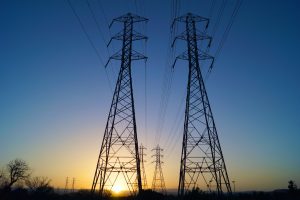 Since man had power on the earth, man has also had power outages. Power outages are one thing, but rolling blackouts are another thing altogether. “A rolling blackout, also known as rotational load shedding, feeder rotation, or a rotating outage is an intentionally-engineered electrical power shutdown in which electricity delivery is stopped for non-overlapping periods of time over different parts of the distribution region.” This type of shutdown…rolling blackouts…are a supposed to be a last-resort measure used by an electric utility company to avoid a total blackout of the power system. I can understand that in a serious heat wave, even though it is a dangerous maneuver, and I can even understand it in an overload caused by an unexpected cold snap, even thought that is also seriously dangerous.
Since man had power on the earth, man has also had power outages. Power outages are one thing, but rolling blackouts are another thing altogether. “A rolling blackout, also known as rotational load shedding, feeder rotation, or a rotating outage is an intentionally-engineered electrical power shutdown in which electricity delivery is stopped for non-overlapping periods of time over different parts of the distribution region.” This type of shutdown…rolling blackouts…are a supposed to be a last-resort measure used by an electric utility company to avoid a total blackout of the power system. I can understand that in a serious heat wave, even though it is a dangerous maneuver, and I can even understand it in an overload caused by an unexpected cold snap, even thought that is also seriously dangerous.
I don’t know a lot about the energy industry, but I do know that some of the recent cuts in types of energy resources are very dangerous when it comes to making sure that we have enough energy for our country. It 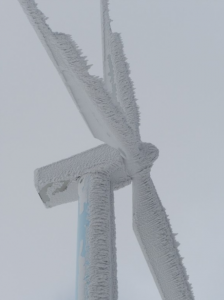 seems that these states who don’t regularly need large amounts of energy for heating and cooling, don’t have a way to “stockpile” any either. Rolling blackouts are used as a response strategy to cope with reduced output beyond reserve capacity from power stations taken offline unexpectedly, such as an extreme weather event. So, when an emergency occurs, their solution is to have these rolling blackouts. California has done this for years.
seems that these states who don’t regularly need large amounts of energy for heating and cooling, don’t have a way to “stockpile” any either. Rolling blackouts are used as a response strategy to cope with reduced output beyond reserve capacity from power stations taken offline unexpectedly, such as an extreme weather event. So, when an emergency occurs, their solution is to have these rolling blackouts. California has done this for years.
The theory behind the rolling blackouts is a “measure of demand” response. If the demand for electricity exceeds the power supply capability of the network, it’s time to have a planned blackout. Rolling blackouts might be limited to a single city or state, or they can be district or nationwide. The whole thing depends on the network and the stockpile of energy resources. Rolling blackouts generally result from two causes. These are insufficient generation capacity or inadequate transmission infrastructure to deliver power to where it is needed.
For California the rolling blackouts had began on June 14th, 2000 due to a heatwave. Other dates for rolling blackouts in those first couple of years were January 17-18, 2001, March 19-20, 2001, and May 7-8, 2001. These were the beginning dates of the California electricity crisis which included extremely high prices and  rolling blackouts. In reality, the “crisis” was a direct result from the manipulation of energy of a partially deregulated California energy system by companies like Enron and Reliant Energy. I wonder too, if the mismanagement wasn’t also on the part of the state’s mismanagement. The recent power outages in Texas from the freezing weather were also rolling blackouts, and the problems they caused were far worse than the California rolling blackouts, because of all the things that froze up from the severe cold. The reality is that one way or the other, our government has to stop limiting the production of our energy resources. That is my opinion, and I’m sure some would disagree, but these rolling blackouts are ridiculous.
rolling blackouts. In reality, the “crisis” was a direct result from the manipulation of energy of a partially deregulated California energy system by companies like Enron and Reliant Energy. I wonder too, if the mismanagement wasn’t also on the part of the state’s mismanagement. The recent power outages in Texas from the freezing weather were also rolling blackouts, and the problems they caused were far worse than the California rolling blackouts, because of all the things that froze up from the severe cold. The reality is that one way or the other, our government has to stop limiting the production of our energy resources. That is my opinion, and I’m sure some would disagree, but these rolling blackouts are ridiculous.
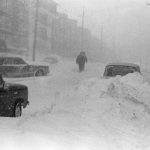
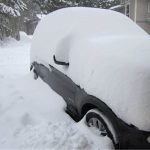 As the United States is in the grip of a fierce snow storm, I am reminded of another snow storm that happened February 21 – 23, 1971. The storm is considered Oklahoma’s extreme storm. This blizzard buried northwestern Oklahoma under as much as three feet of snow, and that doesn’t include the drifting. The town of Buffalo was the hardest hit. They reported 23 inches of snow on the 21st alone, and a state-record snow depth of 36 inches by the morning of the 24th. The northern part of the state was just buried.
As the United States is in the grip of a fierce snow storm, I am reminded of another snow storm that happened February 21 – 23, 1971. The storm is considered Oklahoma’s extreme storm. This blizzard buried northwestern Oklahoma under as much as three feet of snow, and that doesn’t include the drifting. The town of Buffalo was the hardest hit. They reported 23 inches of snow on the 21st alone, and a state-record snow depth of 36 inches by the morning of the 24th. The northern part of the state was just buried.
Oklahoma tends to be a mild weather state, with temperatures in December, January, and February averaging in the 50s. This week is the anniversary of the 1971 blizzard, which was likely the most intense winter storm ever to hit the Sooner State, although the current storm might rival it now. With the current storm, Oklahoma is seeing temperatures averaging -6°. The prior record was in 1909 at 7°. The power company had had to implement rolling blackouts to assure that the power grids don’t fail. I don’t think they have received the amount of snow with the current storm, but the severity is very similar, when you think about it. Anytime a storm is is bad enough to shut things down, especially the power, it is severe.
When the blizzard of 1971 finally ended, 36 inches of snow was measured in Buffalo, which was the state’s record for the highest snowfall total, but the snow drifts measured as high as 20 feet tall. While northwestern Oklahoma was hit very hard, just a short distance to the west in the Oklahoma Panhandle, only light snow fell with Boise City receiving only 3 inches and only 2 inches in Kenton. The 1971 storm put ranchers in a precarious position until C-124s from the Oklahoma Air National Guard dropped 150 tons of hay to stranded Oklahoma cattle. Local cattleman flew along with the aircraft to guide the aircrews to the stranded cattle. The massive loss numbers of 15,000 in livestock accounted for much of the $2 million in damages.
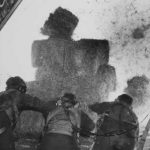
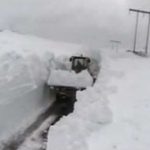 The vicious storm became known as the 84-hour blizzard. It actually occurred across the eastern half of the Texas and Oklahoma Panhandles. The storm his the worst un Oklahoma, but in the region, 8 deaths were reported…7 in Pampa, 1 in the Oklahoma Panhandle. The average drifts were 10 to 20 feet. Storms like these will not likely be soon forgotten, if they are ever forgotten. People are really never prepared for such cold temperatures and so much snow in the southern states. We can try to prepare, but when year after year goes by without such a sever storm, we soon become complacent, until the next one hits us, that is.
The vicious storm became known as the 84-hour blizzard. It actually occurred across the eastern half of the Texas and Oklahoma Panhandles. The storm his the worst un Oklahoma, but in the region, 8 deaths were reported…7 in Pampa, 1 in the Oklahoma Panhandle. The average drifts were 10 to 20 feet. Storms like these will not likely be soon forgotten, if they are ever forgotten. People are really never prepared for such cold temperatures and so much snow in the southern states. We can try to prepare, but when year after year goes by without such a sever storm, we soon become complacent, until the next one hits us, that is.

 Anyone who knows anything about the space program, knows about the disasters that have come out of it…or at least some of them. One of those disasters, the breakup of Space Shuttle Columbia, happened 18 years ago today, February 1, 2003. The breakup upon re-entry into Earth’s atmosphere took the lives of all seven astronauts on board, in a way that we can only imagine as horrific. The best we can hope for following the tragedy is that the astronauts were killed instantly, so they did not suffer in what followed the breakup. It was a horrible day for the United States, and for NASA, but what followed that terrible disaster was a truly remarkable phenomena.
Anyone who knows anything about the space program, knows about the disasters that have come out of it…or at least some of them. One of those disasters, the breakup of Space Shuttle Columbia, happened 18 years ago today, February 1, 2003. The breakup upon re-entry into Earth’s atmosphere took the lives of all seven astronauts on board, in a way that we can only imagine as horrific. The best we can hope for following the tragedy is that the astronauts were killed instantly, so they did not suffer in what followed the breakup. It was a horrible day for the United States, and for NASA, but what followed that terrible disaster was a truly remarkable phenomena.
It is tragedies like the Space Shuttle Columba that bring out the true American spirit. Feelings are set aside, and you suddenly see people hugging each other to comfort them. Columbia broke up in the skies of East Texas on its way back home to Kennedy Space Center. Almost immediately after losing the craft, the NASA world and many others, converged on the small town of Hemphill, Texas. Everyone wanted to help, and many who were not called into service, volunteered. The Space Program had become so commonplace and so routine that such an event came as a horrible shock to this nation and to the world. Suddenly we were glued to our television sets or radios, waiting for news, hoping against hope that there might be survivors, but knowing that it was clearly not possible.
It wasn’t just the NASA teams who showed up for this tragic event. Restaurants gave free meals to the workers. People reported anything they found so it could be documented and processed. The townspeople were there to offer comfort to those in need, because lets face it, these astronauts were members of the NASA family, and NASA (as well as the rest of the nation) was in mourning. As time went on, more and more searchers converged on Hemphill and the surrounding area. The local heroes continued to step up, giving any kind of support needed. This might seem like a small feat to some people, but this search went on for three months. That is a long time to care for so many in such a small town, but it was desperately needed, and 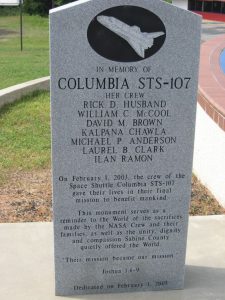
 gratefully received. After a long, drawn-out search, the teams had found all the seemed to be going to find, and almost as quickly as they had arrived, the teams were gone, and the small town of Hemphill, Texas was quiet again, but it would never be the same again. Three months in 2003 had changed it forever. The people who lived there in that time will never forget what they did back then, and we will never forget what they did. It was an awesome feat of kindness and love for our fellow man.
gratefully received. After a long, drawn-out search, the teams had found all the seemed to be going to find, and almost as quickly as they had arrived, the teams were gone, and the small town of Hemphill, Texas was quiet again, but it would never be the same again. Three months in 2003 had changed it forever. The people who lived there in that time will never forget what they did back then, and we will never forget what they did. It was an awesome feat of kindness and love for our fellow man.
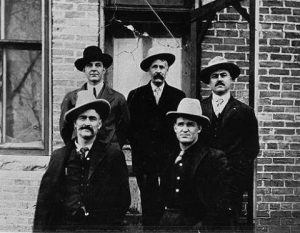 In the early years of Wyoming’s history, there was contention between cattle ranchers and sheep ranchers. The cattlemen thought the land was theirs, and they thought the sheepmen were invading their domain, and they weren’t going to allow it. Cattlemen were first to arrive in the Big Horn Basin, trailing in huge herds of cattle in 1879. They insisted their early arrival established a prior claim to the grass on the government land where their herds grazed. But the law said otherwise. The Cattle and Sheep Wars sprung from this dispute in the Western United States, but they were most common in Texas, Arizona, and the border region of Wyoming and Colorado. The cattlemen thought the sheep destroyed the public grazing lands, which they had to share on a first-come, first-served basis.
In the early years of Wyoming’s history, there was contention between cattle ranchers and sheep ranchers. The cattlemen thought the land was theirs, and they thought the sheepmen were invading their domain, and they weren’t going to allow it. Cattlemen were first to arrive in the Big Horn Basin, trailing in huge herds of cattle in 1879. They insisted their early arrival established a prior claim to the grass on the government land where their herds grazed. But the law said otherwise. The Cattle and Sheep Wars sprung from this dispute in the Western United States, but they were most common in Texas, Arizona, and the border region of Wyoming and Colorado. The cattlemen thought the sheep destroyed the public grazing lands, which they had to share on a first-come, first-served basis.
On April 2, 1909, the range war between the cattlemen and sheepmen in the Ten Sleep, Wyoming area came to a head, when a group of cattlemen decided that they were going to settle this battle once and for all. They headed to Spring Creek seven miles south of Ten Sleep, Wyoming where they knew of a camp. This was to be the last of the sheep raids in the Big Horn Basin. That fateful day, seven cattlemen attacked a sheep camp near  Spring Creek, just south of Ten Sleep, in the southern Big Horn Basin. When the raiders attacked, they killed three men, two of whom the burned to death in their sheep wagon. Then shooting the third man, the decided to kidnap two others. Then they killed the sheep dogs and dozens of sheep and destroyed thousands of dollars of personal property. It was the deadliest sheep raid in Wyoming history. I understand killing in war, but this was murder, and it was horrific!!
Spring Creek, just south of Ten Sleep, in the southern Big Horn Basin. When the raiders attacked, they killed three men, two of whom the burned to death in their sheep wagon. Then shooting the third man, the decided to kidnap two others. Then they killed the sheep dogs and dozens of sheep and destroyed thousands of dollars of personal property. It was the deadliest sheep raid in Wyoming history. I understand killing in war, but this was murder, and it was horrific!!
Wyoming was a territory from July 25, 1868 to July 10, 1890. Early on, there were more cattle ranches than sheep ranches, and the cattlemen felt like they had priority to public lands. Sheep raids began to plague Wyoming since the late 1890s, by which time sheep outnumbered cattle on Wyoming ranges. By 1909, at least six men had been killed, thousands of sheep had been slaughtered, and many thousands of dollars of property destroyed. Nevertheless, there had not been a single conviction for a crime committed during a sheep raid.
It’s really no surprise, given the rising numbers of sheep on the range in those years, that cattlemen were 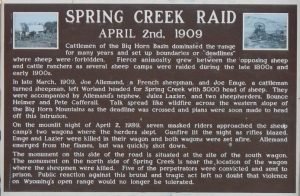 feeling pressured. By 1894 there were 1.7 million sheep in Wyoming and only 675,000 cattle. By 1909, the state’s peak year for sheep, there were more than six million sheep, and only 675,000 cattle. It makes sense that there were tensions, but that did not excuse the men on either side committing murder. Yes, Wyoming was a part of the wild west, and the lawmen were not always readily available, but that did not mean that these men should be able to kill the competition. We are ultimately, civilized people after all, even if we do live in the wild west. After the arrests for the Spring Creek Raid, the cattlemen we reluctant to raid the sheep camps, and with that, a horrific event of the old west passed into history.
feeling pressured. By 1894 there were 1.7 million sheep in Wyoming and only 675,000 cattle. By 1909, the state’s peak year for sheep, there were more than six million sheep, and only 675,000 cattle. It makes sense that there were tensions, but that did not excuse the men on either side committing murder. Yes, Wyoming was a part of the wild west, and the lawmen were not always readily available, but that did not mean that these men should be able to kill the competition. We are ultimately, civilized people after all, even if we do live in the wild west. After the arrests for the Spring Creek Raid, the cattlemen we reluctant to raid the sheep camps, and with that, a horrific event of the old west passed into history.
 Most of us learned about Davy Crockett in school, but I don’t think that most of us really knew very much about him. Davy Crockett was an incredibly “macho” man. He was also an incredibly loyal man. During the War of 1812, the Creek Indian tribe split into factions. I suppose they thought to divide and conquer. One group, the Red Sticks, attacked Fort Mims on August 30, 1830, taking the lives of militiamen, civilians, and Creek allies. The Fort Mims massacre brought national outrage. Many men began to volunteer to fight the Creek Indians. Davy Crockett was among them. Crockett recalled, that he “had none of the dread of dying that I expected to feel,” but his wife, Mary “Polly” Finley did not share his optimism. She was terrified of losing her husband, and begged him not to go. Crockett felt obligated, and he did go. While he was off fighting, Polly became ill and passed away shortly after his return home. Crockett had 3 children with Polly…John Wesley, William, and Margaret.
Most of us learned about Davy Crockett in school, but I don’t think that most of us really knew very much about him. Davy Crockett was an incredibly “macho” man. He was also an incredibly loyal man. During the War of 1812, the Creek Indian tribe split into factions. I suppose they thought to divide and conquer. One group, the Red Sticks, attacked Fort Mims on August 30, 1830, taking the lives of militiamen, civilians, and Creek allies. The Fort Mims massacre brought national outrage. Many men began to volunteer to fight the Creek Indians. Davy Crockett was among them. Crockett recalled, that he “had none of the dread of dying that I expected to feel,” but his wife, Mary “Polly” Finley did not share his optimism. She was terrified of losing her husband, and begged him not to go. Crockett felt obligated, and he did go. While he was off fighting, Polly became ill and passed away shortly after his return home. Crockett had 3 children with Polly…John Wesley, William, and Margaret.
Losing Polly was very hard, but as often happened in those days, marriage after the loss of a wife came out of necessity. Davy needed someone to care for his children. He met a widow woman, Elizabeth Patton, who had children, and who lived nearby. Circumstances being what they were, Crockett began to visit the woman and after discovering his “company wasn’t at all disagreeable to her,” he decided he “could treat her children with so much friendship as to make her a good stepmother.” They married a short time later.
Crockett decided to move his family to Texas, but Elizabeth, while fine with that, asked that he go first to prepare things, and make sure he liked it there before they moved the family. It was probably a good thing in retrospect. Crockett arrived in East Texas in January 1836. He traveled through Nacogdoches and San Augustine before arriving in San Antonio. By the time he got there, the Texas Revolution was in full swing, and included thousands of Mexican troops led by Antonio López de Santa Anna. Their goal was to stop the Texas  independence movement. The battle was fierce, and in the end, approximately 200 Texas militiamen were hunkered in at the Alamo when Santa Anna and his men arrived in February 1836. Crockett and the other men inside gathered supplies and did their best to prepare for the coming siege. Crockett was said to have helped with moral by making jokes and telling stories. The siege of the Alamo lasted 13 days, with the severely outnumbered Texans holding out until the walls of the compound were breached on March 6. As we all know, the men and women inside were all killed. Crockett was also killed, and that left Elizabeth widowed for a second time, but with more children this time. Still, by not taking the family, their lives were spared. Davy Crockett died at the age of 50 years.
independence movement. The battle was fierce, and in the end, approximately 200 Texas militiamen were hunkered in at the Alamo when Santa Anna and his men arrived in February 1836. Crockett and the other men inside gathered supplies and did their best to prepare for the coming siege. Crockett was said to have helped with moral by making jokes and telling stories. The siege of the Alamo lasted 13 days, with the severely outnumbered Texans holding out until the walls of the compound were breached on March 6. As we all know, the men and women inside were all killed. Crockett was also killed, and that left Elizabeth widowed for a second time, but with more children this time. Still, by not taking the family, their lives were spared. Davy Crockett died at the age of 50 years.
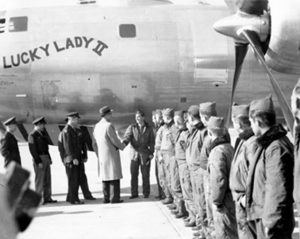 When flight first began, I seriously doubt that anyone had any idea how far it would go. Many people said, “If God had wanted us to fly, He would have given us wings!” Of course, wings can be added…if you know how to add them. The Wright brothers figured out how to add those wings, and how to make them fly. Nevertheless, any kind of long distance fight was still far in the future, back then.
When flight first began, I seriously doubt that anyone had any idea how far it would go. Many people said, “If God had wanted us to fly, He would have given us wings!” Of course, wings can be added…if you know how to add them. The Wright brothers figured out how to add those wings, and how to make them fly. Nevertheless, any kind of long distance fight was still far in the future, back then.
Then, on July 25, 1909, Louis Blériot took off from a field in France, and flew his flimsy monoplane northward for half an hour, and landed near Dover Castle in England. The flight…at the time, daring beyond belief…caused a sensation in Britain. No one thought it could be done, and much less that a mere 40 years later, a plane would actually make a non-stop around the world trip…successfully. Nevertheless, forty years later, Captain James G. Gallagher and a 13-man crew took off from Carswell AFB, Texas, in a B-50 bomber named Lucky Lady II. Four days later they landed back at Carswell. This achievement, the first nonstop flight around the world, also stirred the public imagination.
Neither event involved a major breakthrough in technology, but each was significant for other reasons. Blériot’s flight lasted a mere 37 minutes. In several demonstration flights in France during the previous year, Wilbur Wright had stayed aloft much longer. Blériot was the first to use a combination of hand/arm-operated joystick and foot-operated rudder control, that is in use to the present day, for the basic format of aerodynamic aircraft control systems. Blériot was also the first to make a working, powered, piloted monoplane. In 1909 he became world-famous for making the first airplane flight across the English Channel.
Lucky Lady II took off from Carswell Air Force Base in Fort Worth, Texas. A B-50 Superfortress, Lucky Lady II 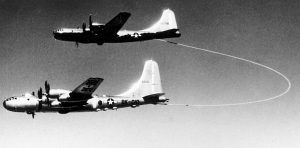 flew the first nonstop round-the-world flight. The aircraft averaged 249 miles per hour on its 23,452 mile flight. The Lucky Lady II was refueled four times in the air by B-29 tanker planes and on March 2 returned to the United States after 94 hours in the air. It was a record breaking flight. Of course, the record would not last forever. In December 1986, Voyager, a lightweight propeller plane constructed mainly of plastic, landed at Edwards Air Force Base in Muroc, California, having completed the first global flight without refueling. Flight will most likely never stop improving.
flew the first nonstop round-the-world flight. The aircraft averaged 249 miles per hour on its 23,452 mile flight. The Lucky Lady II was refueled four times in the air by B-29 tanker planes and on March 2 returned to the United States after 94 hours in the air. It was a record breaking flight. Of course, the record would not last forever. In December 1986, Voyager, a lightweight propeller plane constructed mainly of plastic, landed at Edwards Air Force Base in Muroc, California, having completed the first global flight without refueling. Flight will most likely never stop improving.
 While most of the economy in Southeast Texas depended on agriculture, cattle ranching, and the lumber business in the 19th century, things were about to change. The presence of oil was known, but untapped until 1901 when the oil industry would change the landscape of the region. Uses for oil date back many years. In the 1500s, the Spanish used oil from seeps near Sabine Pass for caulking their ships, and to the north, settlers near Nacogdoches used seeping oil for lubricants before 1800. There were numerous discoveries in east and central Texas in the later 1800s, especially at Corsicana in 1896. Attempts were made to drill wells at Spindletop 1893 and 1896 and at Sour Lake in 1896, but they had no successful oil production along the Gulf Coast until the Lucas Gusher came in on Spindletop Hill on January 10, 1901.
While most of the economy in Southeast Texas depended on agriculture, cattle ranching, and the lumber business in the 19th century, things were about to change. The presence of oil was known, but untapped until 1901 when the oil industry would change the landscape of the region. Uses for oil date back many years. In the 1500s, the Spanish used oil from seeps near Sabine Pass for caulking their ships, and to the north, settlers near Nacogdoches used seeping oil for lubricants before 1800. There were numerous discoveries in east and central Texas in the later 1800s, especially at Corsicana in 1896. Attempts were made to drill wells at Spindletop 1893 and 1896 and at Sour Lake in 1896, but they had no successful oil production along the Gulf Coast until the Lucas Gusher came in on Spindletop Hill on January 10, 1901.
Spindletop Hill was a salt dome oil field, that was located in the southern portion of Beaumont, Texas. People had long suspected that oil might be under the hill as the area had been known for its sulfur springs and  bubbling gas seepages that would ignite if lit. Then in August, 1892, several men including George W. O’Brien, George W. Carroll, and Pattillo Higgins formed the Gladys City Oil, Gas, and Manufacturing Company to do exploratory drilling on Spindletop Hill.
bubbling gas seepages that would ignite if lit. Then in August, 1892, several men including George W. O’Brien, George W. Carroll, and Pattillo Higgins formed the Gladys City Oil, Gas, and Manufacturing Company to do exploratory drilling on Spindletop Hill.
By September 1901, there were at least six successful wells on Gladys City Company lands. Wild speculation drove land prices around Spindletop to incredible heights. One man who had been trying to sell his tract there for $150 for three years sold his land for $20,000; the buyer promptly sold to another investor within fifteen minutes for $50,000. One well, representing an initial investment of under $10,000, was sold for $1,250,000. Legal entanglements and multimillion-dollar deals became almost commonplace. An estimated $235 million had been invested in oil that year in Texas; while some had made fortunes, others lost everything.
Following the success of the oil industry at Spindletop Hill, many people, including my grandparents, Allen and 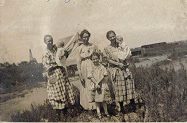 Anna Spencer would make their way to Texas in search of a better life. They would settle on the oilfields near Ranger, Texas. They didn’t find any oil fields, so their income came from his work for other people in the oilfields. These days people working in the oilfield business make good money, but as near as I can tell oilfield workers averaged about 90 cents an hour in 1919, which would be about $11.74 an hour today. That’s pretty poor wages, especially for the oilfield, but I suppose people didn’t realize how valuable they really were. Needless to say, the oilfield was not the place my grandfather would choose to make his living, and eventually they returned to Wisconsin where he went to work for the railroad.
Anna Spencer would make their way to Texas in search of a better life. They would settle on the oilfields near Ranger, Texas. They didn’t find any oil fields, so their income came from his work for other people in the oilfields. These days people working in the oilfield business make good money, but as near as I can tell oilfield workers averaged about 90 cents an hour in 1919, which would be about $11.74 an hour today. That’s pretty poor wages, especially for the oilfield, but I suppose people didn’t realize how valuable they really were. Needless to say, the oilfield was not the place my grandfather would choose to make his living, and eventually they returned to Wisconsin where he went to work for the railroad.
 My niece, Kelli Schulenberg hates the winter cold, but since she lives in Wyoming, and we get winter here, like it or not, Kelli has been learning to adapt. She has always loved hiking, and spending time in the mountains, but the wintertime was simply not her favorite time of year. Nevertheless, I think that Kelli is coming around to the Wyoming way of thinking. Ok, maybe not, but she is adapting to the winter a little bit anyway. These days Kelli can be found cross country skiing and horseshoeing in the winter on the mountains. Maybe she is adapting more than I have, and I’ve lived here years longer than Kelli has. While I love hiking and being outdoors, especially in the mountains, I have no desire too go skiing or horseshoeing…or anything else that has to do with winter in the outdoors, even though I love Wyoming. Kelli loves to travel, and that’s something we both agree on. She and her husband, Barry have taken many trips to beautiful places
My niece, Kelli Schulenberg hates the winter cold, but since she lives in Wyoming, and we get winter here, like it or not, Kelli has been learning to adapt. She has always loved hiking, and spending time in the mountains, but the wintertime was simply not her favorite time of year. Nevertheless, I think that Kelli is coming around to the Wyoming way of thinking. Ok, maybe not, but she is adapting to the winter a little bit anyway. These days Kelli can be found cross country skiing and horseshoeing in the winter on the mountains. Maybe she is adapting more than I have, and I’ve lived here years longer than Kelli has. While I love hiking and being outdoors, especially in the mountains, I have no desire too go skiing or horseshoeing…or anything else that has to do with winter in the outdoors, even though I love Wyoming. Kelli loves to travel, and that’s something we both agree on. She and her husband, Barry have taken many trips to beautiful places  around the United States. While many of the trips have been to attend concerts, they have gone through some beautiful country too. I’m sure that Kelli will always prefer summer to winter, and probably Texas to Wyoming, but for now, she is adapting.
around the United States. While many of the trips have been to attend concerts, they have gone through some beautiful country too. I’m sure that Kelli will always prefer summer to winter, and probably Texas to Wyoming, but for now, she is adapting.
She is a purist when it comes to the country, enjoying country life, but very much against the industrialization thereof. When she and Barry bought a piece of land east of Casper, it was quiet and peaceful…until a company put up a wind farm behind their house. I have long been fascinated by the big wind turbines, but I have never lived next to one, so quite possibly I don’t know how loud they are. I suppose they would be an eyesore, when located net to your nice, quiet backyard. I also don’t know if they would be a problem, if one were to think about raising donkeys, which has been a lifelong dream of Kelli’s. Maybe, the animals would be spooked by the  wind turbine, for all I know of them. All that doesn’t really matter, because the turbines are there, and they are there to stay.
wind turbine, for all I know of them. All that doesn’t really matter, because the turbines are there, and they are there to stay.
Kelli is a bubbly person, who loves to laugh. She has a great smile, which is most likely what attracted my nephew to her in the first place. She is fun loving and outgoing. Her love of travel has opened many new vistas to Barry, as they have traveled more together than he ever did before their marriage. Whatever else it was that attracted them to each other, it was definitely true love, because they have been married for almost 15 years now, and they are still going strong. It must be love. Today is Kelli’s birthday. Happy birthday Kelli!! Have a great day!! We love you!!
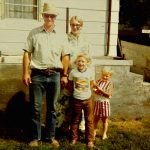 My husband, Bob’s Aunt Pearl Hein is a very ambitious person. For years, she has raised a garden, and canned tons of vegetables. She and Uncle Eddie have long been very busy people…maybe too busy sometimes. Pearl worked for many years at the IGA store in Forsyth, Montana, and pretty much became vital to the functioning of that place. That did make it hard for Pearl to entertain, and at least when we were in town, she always enjoyed having everyone come over for dinner. We didn’t get to Forsyth often, and she liked to make our visit very special. And she did make our visits special…not just because she is a great cook, but because she always made us feel welcome. Going to visit Eddie and Pearl was always a highlight of our visits to Forsyth.
My husband, Bob’s Aunt Pearl Hein is a very ambitious person. For years, she has raised a garden, and canned tons of vegetables. She and Uncle Eddie have long been very busy people…maybe too busy sometimes. Pearl worked for many years at the IGA store in Forsyth, Montana, and pretty much became vital to the functioning of that place. That did make it hard for Pearl to entertain, and at least when we were in town, she always enjoyed having everyone come over for dinner. We didn’t get to Forsyth often, and she liked to make our visit very special. And she did make our visits special…not just because she is a great cook, but because she always made us feel welcome. Going to visit Eddie and Pearl was always a highlight of our visits to Forsyth.
Pearl married Bob’s uncle Eddie on July 15, 1962, and they had two children, Larry Hein and Kimberly (Hein) Arani. They were then busily raising their family and spending time with siblings and parents. When Pearl’s parents needed help i their later years,she was right there to help them, often spending long hours at their homes. I remember many times that they were not able to take vacations because they were so busy. Now that they are both retired, they have more time to travel a little, and they have made a  couple of trips to Texas to visit their daughter, who lives there. I like that they can get away sometimes to a warmer climate, and I’m sure Kim likes it too.
couple of trips to Texas to visit their daughter, who lives there. I like that they can get away sometimes to a warmer climate, and I’m sure Kim likes it too.
Their son, Larry and his family still live in Forsyth, and for them as well as Eddie and Pearl, that will always be home. I’m not sure any of them will ever live anywhere else, and I can understand that. Forsyth is a cute little town, with a rich history. The family, from many branches, has roots there. While none of my own family were born there, Forsyth, and all of Bob’s family who are still there, will always hold a special place in my heart. And Pearl had a big part in those memories. Today is Pearl’s birthday. Happy birthday Pearl!! Have a great day!! We love you!!
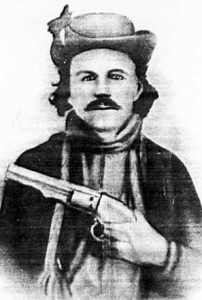 People love to fight…be it in a war, debate, argument, or feud. It’s not so much a matter of loving to fight really, as it is an inability to get along, due to very differing opinions and ideas. One of the best known of all the feuds in Texas was the Lee-Peacock Feud. This feud took place in northeast Texas following the Civil War. It was a continuation of the war that would last for four bloody years after the rest of the nation had laid down their arms.The feud was fought in the Corners region of northeast Texas, where Grayson, Fannin, Hunt, and Collin Counties converged in an area known as the “Wildcat Thicket.” This thicket, covering many square miles, was so dense with trees, tall grass, brier brush, and thorn vines, that few people had even ventured into it until the Civil War, when it became a haven for army deserters and outlaws. It was in the northern part of this thicket that Daniel W Lee had built his home and raised his son, Bob Lee, who would become one of the leaders in the feud that was to come.
People love to fight…be it in a war, debate, argument, or feud. It’s not so much a matter of loving to fight really, as it is an inability to get along, due to very differing opinions and ideas. One of the best known of all the feuds in Texas was the Lee-Peacock Feud. This feud took place in northeast Texas following the Civil War. It was a continuation of the war that would last for four bloody years after the rest of the nation had laid down their arms.The feud was fought in the Corners region of northeast Texas, where Grayson, Fannin, Hunt, and Collin Counties converged in an area known as the “Wildcat Thicket.” This thicket, covering many square miles, was so dense with trees, tall grass, brier brush, and thorn vines, that few people had even ventured into it until the Civil War, when it became a haven for army deserters and outlaws. It was in the northern part of this thicket that Daniel W Lee had built his home and raised his son, Bob Lee, who would become one of the leaders in the feud that was to come.
When the Civil War broke out, Bob Lee, by that time married with three children, quickly joined the Confederate Army, serving with the Ninth Texas Cavalry. Other young men in the area, including the Maddox brothers…John, William, and Francis; their cousin Jim Maddox, and several of the Boren boys, also joined the Ninth. Towards the end of the war, Bob heard that the Union League, an organization that worked for the protection of the blacks and Union sympathizers, had set up its North Texas headquarters at Pilot Grove, just about seven miles away from the Lee family homes.
The head of the Union League was a man named Lewis Peacock, who had arrived in Texas in 1856 and lived just south of Pilot Grove. Federal Troops were sent to Texas to aid in reconstruction efforts. By the time the Confederate soldiers returned to their homes in northeast Texas, the area was already in heavy conflict. Whether they owned slaves or not, most area residents resented the intrusion of Reconstruction ideals and new laws. When Bob Lee returned home, he was seen as a natural leader for the “Civil War” that was still being fought in northeast Texas.
To Peacock, Lee was seen as a threat to his cause and to reconstruction itself. To remove this threat, the Union League conceived of the idea to extort money from Lee. Peacock and his cohorts arrived at Lee’s house one night and “arrested” him, allegedly for crimes that he had committed during the Civil War. Lee would later say that he recognized the men as Lewis Peacock, James Maddox, Bill Smith, Sam Bier, Hardy Dial, Doc Wilson, and Israel Boren. Stating to Lee that he was to be taken into Sherman, they instead stopped in Choctaw Creek bottoms, where they took Lee’s watch, a $20 gold coin, and forced him to sign a promissory note for $2,000. The Lee’s refused to pay the note, bringing suit in Bonham, Texas and winning the case. This was the start of an all-out war, known as the Lee-Peacock Feud.
Both men gathered their friends and sympathizers and from 1867 through June 1869, a second “Civil War” raged in northeast Texas. An estimated 50 men losing their lives. By the summer of 1868, it had become so heated that the Union League requested help from the Federal Government, to which General JJ Reynolds posted a reward of $1,000 for the capture of Bob Lee. In late February, 1867, Lee was in a store in Pilot Grove when he ran across Jim Maddox, one of the men who had kidnapped him. Confronting Maddox, Lee offered Maddox a gun so they could fight. When Lee turned around to walk away, a bullet grazed his ear and head and he fell to the ground unconscious. Lee was taken to Dr William H Pierce, who treated him in his home. A report went to Austin to the Headquarters of the Fifth Military District under command of General John J. Reynolds, and the following entry was made in his ledger: “Murder and Assaults with Intent to Kill”, listed as criminals were James Maddox and John Vaught, listed as injured was Robert Lee. The charge: “Assault with intent to murder.” The result: “Set aside by the Military”. A few days later, on February 24, 1867, while Lee was still, convalescing in Pierce’s home, the doctor was shot to death by Hugh Hudson, a known Peacock man. Lee swore to avenge Pierce’s death and as word spread to both sides of the conflict, neighbors in the thickets of Four Corners began to arm themselves.
Hugh Hudson, the doctor’s killer was later shot at Saltillo, a teamster’s stop on the road to Jefferson. The feud had begun in full force. In 1868, Lige Clark, Billy Dixon, Dow Nance, Dan Sanders, Elijah Clark, and John Baldock were killed and many others wounded. Even Peacock suffered a wound at the hands of Lee’s followers. On August 27, 1868, General J. J. Reynolds issued the $1,000 reward for Bob Lee, dead or alive, an act that attracted bounty hunters from all over the country to the “Four Corners.” Three of these men, union sympathizers from Kansas, converged on the area in the early spring of 1869 to try to capture Lee. Instead, all three were found dead on the road. Bob Lee, in the meantime, had set up a hideout in the “Wildcat Thicket.”
General JJ Reynolds responded by dispatching the Fourth United States Cavalry to search for Lee and attempt to settle the trouble in the area. As they began a search from house to house for Lee, in which several gun battles ensued and several men were killed. In the end, one of Bob Lee’s “supporters,” a man named Henry Boren, betrayed him to the cavalry who shot down Lee on May 24, 1869. Later, Boren was shot down by his 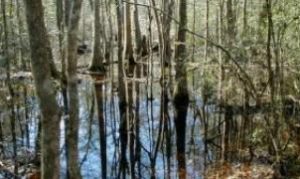 own nephew, Bill Boren, who was a Lee supporter and felt that a “traitor” had to be put to death. After he killed his uncle, Bill Boren left the area and began to ride with John Wesley Hardin.
own nephew, Bill Boren, who was a Lee supporter and felt that a “traitor” had to be put to death. After he killed his uncle, Bill Boren left the area and began to ride with John Wesley Hardin.
As the Texas authorities had hoped, the killing of Lee began to dissolve the heated dispute, as many men scattered to other parts of the state. Though they were fewer in number, the “war” continued for two years, as more men were killed in both the four-corners region and other parts of the state. It wouldn’t be until Lewis Peacock was shot on June 13, 1871, that the feud finally ended.

